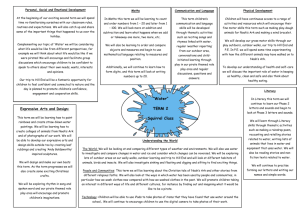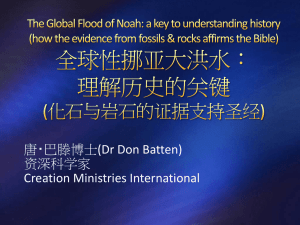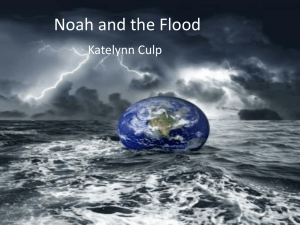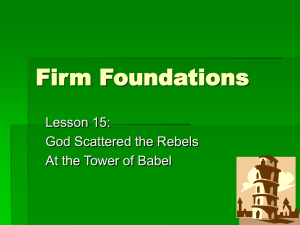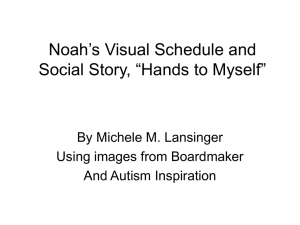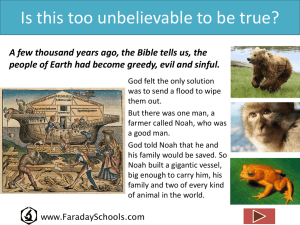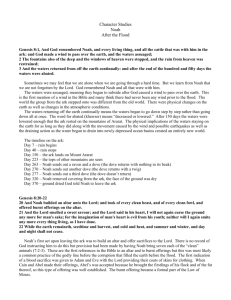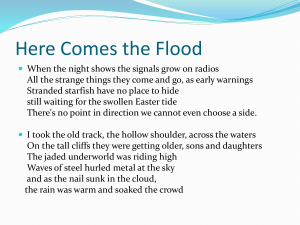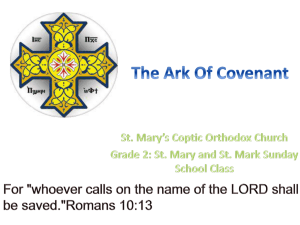Reading Noah and the flood through the Source Theory Lens
advertisement
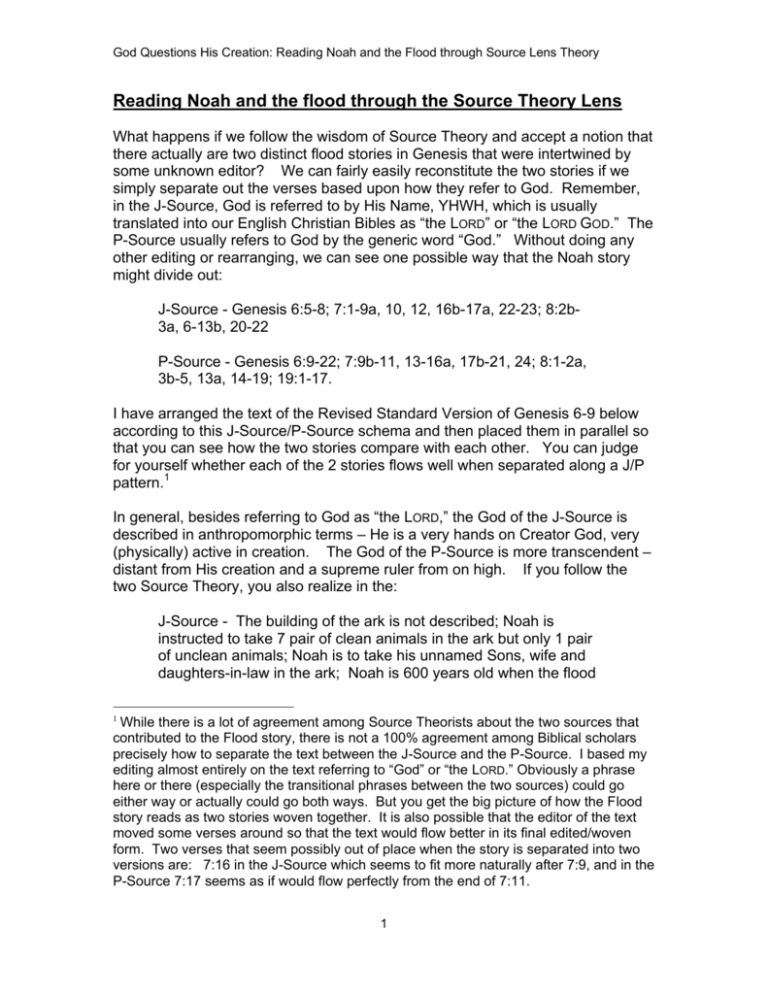
God Questions His Creation: Reading Noah and the Flood through Source Lens Theory Reading Noah and the flood through the Source Theory Lens What happens if we follow the wisdom of Source Theory and accept a notion that there actually are two distinct flood stories in Genesis that were intertwined by some unknown editor? We can fairly easily reconstitute the two stories if we simply separate out the verses based upon how they refer to God. Remember, in the J-Source, God is referred to by His Name, YHWH, which is usually translated into our English Christian Bibles as “the LORD” or “the LORD GOD.” The P-Source usually refers to God by the generic word “God.” Without doing any other editing or rearranging, we can see one possible way that the Noah story might divide out: J-Source - Genesis 6:5-8; 7:1-9a, 10, 12, 16b-17a, 22-23; 8:2b3a, 6-13b, 20-22 P-Source - Genesis 6:9-22; 7:9b-11, 13-16a, 17b-21, 24; 8:1-2a, 3b-5, 13a, 14-19; 19:1-17. I have arranged the text of the Revised Standard Version of Genesis 6-9 below according to this J-Source/P-Source schema and then placed them in parallel so that you can see how the two stories compare with each other. You can judge for yourself whether each of the 2 stories flows well when separated along a J/P pattern.1 In general, besides referring to God as “the LORD,” the God of the J-Source is described in anthropomorphic terms – He is a very hands on Creator God, very (physically) active in creation. The God of the P-Source is more transcendent – distant from His creation and a supreme ruler from on high. If you follow the two Source Theory, you also realize in the: J-Source - The building of the ark is not described; Noah is instructed to take 7 pair of clean animals in the ark but only 1 pair of unclean animals; Noah is to take his unnamed Sons, wife and daughters-in-law in the ark; Noah is 600 years old when the flood 1 While there is a lot of agreement among Source Theorists about the two sources that contributed to the Flood story, there is not a 100% agreement among Biblical scholars precisely how to separate the text between the J-Source and the P-Source. I based my editing almost entirely on the text referring to “God” or “the LORD.” Obviously a phrase here or there (especially the transitional phrases between the two sources) could go either way or actually could go both ways. But you get the big picture of how the Flood story reads as two stories woven together. It is also possible that the editor of the text moved some verses around so that the text would flow better in its final edited/woven form. Two verses that seem possibly out of place when the story is separated into two versions are: 7:16 in the J-Source which seems to fit more naturally after 7:9, and in the P-Source 7:17 seems as if would flow perfectly from the end of 7:11. 1 God Questions His Creation: Reading Noah and the Flood through Source Lens Theory begins; Noah, et al, are in the ark 7 days before the flood actually begins; the flood is caused by a rain storm which lasts 40 days, the waters basically cover the tree tops (but not the mountain tops as they do in the P-Source), and on the 61st day after entering the ark, Noah leaves the ark. P-Source - The building of the ark is given very specific detail; the names of Noah’s sons are provided; two of each kind of animal is to be taken in the ark; food for all is to be put in the ark; a covenant between God and humans will be established (covenants are indicative that the verses come from the hand of the P-Source); that Noah “did as God commanded” is a repeating refrain in the story (in Genesis 1 also a P-Source story there is the repeating refrain “and God saw that it was good”); exact day of the year and day of the week is provided for the beginning and end of the story (as in Genesis 1 where God creates the world in exactly 7 days); it is the deeps above and below the earth which burst forth with the cataclysmic flood waters – not just a rainstorm, but the waters of Genesis 1 which were contained by God so the dry earth could come into existence are suddenly let loose again; the flood occurs on the very day Noah enters the ark, not 7 days later as in the J-Source; the flood waters rise above the mountain tops; the flood waters increase for 150 days; Noah, et al, are in the ark a total of 340 days In rearranging the stories this way we are not denying the inspiration of either story, nor are we denying the inspiration of the editor who wove the two stories together. Following Source Theory can simply help us deal with some of the logical and narrative inconsistencies in the story. The reason the details in Genesis 6-9 seem disjointed at points or inconsistent is that they actually were derived from two different stories. What is also significant is that the final editor of the Bible did not see a need to totally harmonize the two stories – but did weave them together even though their details do not seamlessly correlate. By not harmonizing the two stories, he left us plenty of clues to the existence of both stories – perhaps he did this intentionally as He found both stories inspiring and revelatory. He wanted to have the Scripture read as one narrative, but then kept details from each story which cannot be reconciled. Apparently he had no divine direction to eliminate the differences in the details. So we need to ask ourselves why do set out to harmonize the differences when the inspired editor of the Bible did not? We of course cannot know if there were any parts of the original two stories that he simply deleted. We also cannot know if any parts of the story were in total agreement and therefore he could pick either of the two to include in his final blended version. Source Theory takes seriously every word of the text. It however does not try to find a way to show all the sentences are literally 2 God Questions His Creation: Reading Noah and the Flood through Source Lens Theory consistent with each other. Sometimes the only way to read the text absolutely literally requires the reader to do “violence” to the text – change its plain meaning so much so that the differences in the story appear not to be differences. It seems in some literal interpretations one has to do mental gymnastics to force the text to be literally consistent. The final editor of the biblical text did not attempt to rid the story of its differences and inconsistencies. So why do we think we should explain them away or eliminate them by forcing an interpretation on them which unnaturally does away with the literal differences? They were left in the text by a man inspired by God, and for a purpose. Let us recognize that, and deal with all of the verses, all of their variations and all of their implications. Since the story of the flood is given as one continuous story in our Scriptures, we will most often read it that way. The story was not handed down to us in the form of two parallel stories, but rather different pieces of the two stories were contiguously placed to have us read it as one “chronological” narrative. The differences in the stories have certainly given Scripture commentators much to comment on as they attempted to harmonize the differences in the stories, and these efforts have given many great insights into both the Scriptures and into the nature of God. The same happens if we read the text as two distinct stories which have been woven together. Since the Patristic writers always assumed that every detail of the Bible is important for gaining wisdom and understanding, they might have found the insight of Source Theory to be one more layer of depth to the Scriptures. Reading the story of Noah and the Flood as two distinct stories is really no different than reading the 4 Gospels as a basic telling of the same story from 4 distinct perspectives (as sometimes the details of the Gospel according to the 4 evangelists do not agree). Generally, when reading Scripture, if you accept it as the inspired word of God, you can have a couple of different approaches when you encounter “inconsistencies” in the test. A) You can accept a notion that the text is inspired and therefore the inconsistencies are apparent but not real. This requires then developing an interpretive method in which you find a way to harmonize the differences – explain them away, spiritualize them, show in some way that they are not in fact inconsistent. The Patristic writers frequently attempted this method as have modern believers who demand that the text be read literally. B) You can also sort out the differences to see if the “inconsistencies” might be explained by there being more than one author/editor/story contributing to the narrative. This is an interpretive method in which you decide not to harmonize the differences, but to accept them as contributing to our understanding of God and His revelation. This method is also frequently used by the Patristic writers (though they never conceived of a different source idea, they did believe that all the differences were placed in the text intentionally by the Holy Spirit and were part of the depth and richness of Scriptures which we are to discover). It is also the method of many modern Biblical scholars. This method tends to assume a non-literal reading of the text and says the importance is not in the literal reading of the text, the importance 3 God Questions His Creation: Reading Noah and the Flood through Source Lens Theory lies in the grand revelation which we encounter in the Scriptures. This generally means we are looking for a deeper meaning beyond the “plain” reading of the words. Even when the Patristic writers accepted the Genesis narrative as literally true, they always also and simultaneously believed the text had much more significance than its “plain” meaning. They frequently looked for the not-soobvious or hidden meaning of the text – and certainly the notion of more than one author remained hidden from them! But they advocated digging deep into the text until all of its meanings were revealed. They always assumed the text had some relationship to and revelation about Christ, and only in Christ would the full meaning of the text be revealed. Is separating out the received text into two separate stories ever an “Orthodox” way of approaching Scripture? One need only think about the “Composite” Old Testament Paramoia which are read during Vespers on the eve of certain Feasts to realize Orthodoxy engaged in similar Bible editing in its own communal and liturgical vocalized reading of Scriptures. Think also of the Gospel Lesson for the feasts of the Virgin Mary – Luke 10:38-42 is connected to and read uninterruptedly and continuously with 11:27-28 giving the Orthodox listener the impression that those texts flow seamlessly and naturally together whereas in Luke’s Gospel they are not connected at all. The Church thus has on limited occasions selectively chosen and “re-arranged” verses to fit its own purposes. The use of ideas from Source Theory are offered here only as one additional tool in the study of the inspired Scriptures of God. Please remember even the chapter and verse numbering system in our Bibles is an invention of biblical scholars as those numbers are not in the original text, and yet they do influence how we think about and read the Scriptures. We often read a “chapter” at a time, but that is following an artificial division introduced into the biblical text by scholars. This numbering system also is a potentially good tool for us, but again we have to recognize it is a tool, it isn’t Scripture. 4 God Questions His Creation: Reading Noah and the Flood through Source Lens Theory J-source P-source 6:9 These are the generations of Noah. Noah was a righteous man, blameless in his generation; Noah walked with God. 10 And Noah had three sons, Shem, Ham, and Japheth. 11 Now the earth was corrupt in God's sight, and the earth was filled with violence. 12 And God saw the earth, and behold, it was corrupt; for all flesh had corrupted their way upon the earth. 13 And God said to Noah, "I have determined to make an end of all flesh; for the earth is filled with violence through them; behold, I will destroy them with the earth. 14 Make yourself an ark of gopher wood; make rooms in the ark, and cover it inside and out with pitch. 15 This is how you are to make it: the length of the ark three hundred cubits, its breadth fifty cubits, and its height thirty cubits. 16 Make a roof for the ark, and finish it to a cubit above; and set the door of the ark in its side; make it with lower, second, and third decks. 17 For behold, I will bring a flood of waters upon the earth, to destroy all flesh in which is the breath of life from under heaven; everything that is on the earth shall die. 18 But I will establish my covenant with you; and you shall come into the ark, you, your sons, your wife, and your sons' wives with you. 19 And of every living thing of all flesh, you shall bring two of every sort into the ark, to keep them alive with you; they shall be male and female. 20 Of the birds according to their kinds, and of the animals according to their kinds, of every creeping thing of the ground according to its kind, two of every sort shall come in to you, to keep them alive. 21 Also take with you every sort of food that is eaten, and store it up; and it shall serve as food for you and for them." 6:5 The LORD saw that the wickedness of man was great in the earth, and that every imagination of the thoughts of his heart was only evil continually. 6 And the LORD was sorry that he had made man on the earth, and it grieved him to his heart. 7 So the LORD said, "I will blot out man whom I have created from the face of the ground, man and beast and creeping things and birds of the air, for I am sorry that I have made them." 8 But Noah found favor in the eyes of the LORD. 7:1 Then the LORD said to Noah, "Go into the ark, you and all your household, for I have seen that you are righteous before me in this generation. 2 Take with you seven pairs of all clean animals, the male and his mate; and a pair of the animals that are not clean, the male and his mate; 3 and seven pairs of the birds of the air also, male and female, to keep their kind alive upon the face of all the earth. 4 For in seven days I will send rain upon the earth forty days and forty nights; and every living thing that I have made I will blot out from the face of the ground." 5 And Noah did all that the LORD had commanded him. 22 Noah did this; he did all that God commanded him. 5 God Questions His Creation: Reading Noah and the Flood through Source Lens Theory J-source P-source 7:6 Noah was six hundred years old when the flood of waters came upon the earth. 7:11 In the six hundredth year of Noah's life, in the second month, on the seventeenth day of the month, on that day all the fountains of the great deep burst forth, and the windows of the heavens were opened. 7:7 And Noah and his sons and his wife and his sons' wives with him went into the ark, to escape the waters of the flood. 8 Of clean animals, and of animals that are not clean, and of birds, and of everything that creeps on the ground, 9 two and two, male and female, went into the ark with Noah, 13 On the very same day Noah and his sons, Shem and Ham and Japheth, and Noah's wife and the three wives of his sons with them entered the ark, 14 they and every beast according to its kind, and all the cattle according to their kinds, and every creeping thing that creeps on the earth according to its kind, and every bird according to its kind, every bird of every sort. 15 They went into the ark with Noah, two and two of all flesh in which there was the breath of life. 16 And they that entered, male and female of all flesh, went in as God had commanded him; 7:17 and the waters increased, and bore up the ark, and it rose high above the earth. 18 The waters prevailed and increased greatly upon the earth; and the ark floated on the face of the waters. 19 And the waters prevailed so mightily upon the earth that all the high mountains under the whole heaven were covered; 20 the waters prevailed above the mountains, covering them fifteen cubits deep. 21 And all flesh died that moved upon the earth, birds, cattle, beasts, all swarming creatures that swarm upon the earth, and every man; . 10 And after seven days the waters of the flood came upon the earth. 7:12 And rain fell upon the earth forty days and forty nights. 7:16 and the LORD shut him in. 7:24 And the waters prevailed upon the earth a hundred and fifty days. 7:17 The flood continued forty days upon the earth 7:22 everything on the dry land in whose nostrils was the breath of life died. 23 He blotted out every living thing that was upon the face of the ground, man and animals and creeping things and birds of the air; they were blotted out from the earth. 8:1 But God remembered Noah and all the beasts and all the cattle that were with him in the ark. And God made a wind blow over the earth, and the waters subsided; 2 the fountains of the deep and the windows of the heavens were closed, Only Noah was left, and those that were with him in the ark. 6 God Questions His Creation: Reading Noah and the Flood through Source Lens Theory J-source P-source 8:2 the rain from the heavens was restrained, 3 and the waters receded from the earth continually. 8:3 At the end of a hundred and fifty days the waters had abated; 4 and in the seventh month, on the seventeenth day of the month, the ark came to rest upon the mountains of Ar'arat. 5 And the waters continued to abate until the tenth month; in the tenth month, on the first day of the month, the tops of the mountains were seen. 8:6 At the end of forty days Noah opened the window of the ark which he had made, 7 and sent forth a raven; and it went to and fro until the waters were dried up from the earth. 8 Then he sent forth a dove from him, to see if the waters had subsided from the face of the ground; 9 but the dove found no place to set her foot, and she returned to him to the ark, for the waters were still on the face of the whole earth. So he put forth his hand and took her and brought her into the ark with him. 10 He waited another seven days, and again he sent forth the dove out of the ark; 11 and the dove came back to him in the evening, and lo, in her mouth a freshly plucked olive leaf; so Noah knew that the waters had subsided from the earth. 12 Then he waited another seven days, and sent forth the dove; and she did not return to him any more. 8:13 In the six hundred and first year, in the first month, the first day of the month, the waters were dried from off the earth; 8:14 In the second month, on the twentyseventh day of the month, the earth was dry. 8:15 Then God said to Noah, 16 "Go forth from the ark, you and your wife, and your sons and your sons' wives with you. 17 Bring forth with you every living thing that is with you of all flesh-birds and animals and every creeping thing that creeps on the earth--that they may breed abundantly on the earth, and be fruitful and multiply upon the earth." 8:13 and Noah removed the covering of the ark, and looked, and behold, the face of the ground was dry. 18 So Noah went forth, and his sons and his wife and his sons' wives with him. 19 And every beast, every creeping thing, and every bird, everything that moves upon the earth, went forth by families out of the ark. 18 So Noah went forth, and his sons and his wife and his sons' wives with him. 19 And every beast, every creeping thing, and every bird, everything that moves upon the earth, went forth by families out of the ark. 7 God Questions His Creation: Reading Noah and the Flood through Source Lens Theory J-source P-source 9:1 And God blessed Noah and his sons, and said to them, "Be fruitful and multiply, and fill the earth. 2 The fear of you and the dread of you shall be upon every beast of the earth, and upon every bird of the air, upon everything that creeps on the ground and all the fish of the sea; into your hand they are delivered. 3 Every moving thing that lives shall be food for you; and as I gave you the green plants, I give you everything. 4 Only you shall not eat flesh with its life, that is, its blood. 5 For your lifeblood I will surely require a reckoning; of every beast I will require it and of man; of every man's brother I will require the life of man. 6 Whoever sheds the blood of man, by man shall his blood be shed; for God made man in his own image. 7 And you, be fruitful and multiply, bring forth abundantly on the earth and multiply in it." 8:20 Then Noah built an altar to the LORD, and took of every clean animal and of every clean bird, and offered burnt offerings on the altar. 8 Then God said to Noah and to his sons with him, 9 "Behold, I establish my covenant with you and your descendants after you, 10 and with every living creature that is with you, the birds, the cattle, and every beast of the earth with you, as many as came out of the ark. 11 I establish my covenant with you, that never again shall all flesh be cut off by the waters of a flood, and never again shall there be a flood to destroy the earth." 21 And when the LORD smelled the pleasing odor, the LORD said in his heart, "I will never again curse the ground because of man, for the imagination of man's heart is evil from his youth; neither will I ever again destroy every living creature as I have done. 12 And God said, "This is the sign of the covenant which I make between me and you and every living creature that is with you, for all future generations: 13 I set my bow in the cloud, and it shall be a sign of the covenant between me and the earth. 14 When I bring clouds over the earth and the bow is seen in the clouds, 15 I will remember my covenant which is between me and you and every living creature of all flesh; and the waters shall never again become a flood to destroy all flesh. 16 When the bow is in the clouds, I will look upon it and remember the everlasting covenant between God and every living creature of all flesh that is upon the earth." 17 God said to Noah, "This is the sign of the covenant which I have established between me and all flesh that is upon the earth." 22 While the earth remains, seedtime and harvest, cold and heat, summer and winter, day and night, shall not cease." 8
